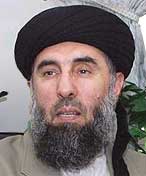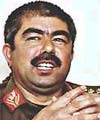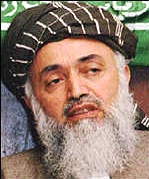|






|
 |
|
|
Feb 13, 2025: Thursday
|
Loading...
|
|
 |
 |
 |
 |
Major Afghan Mujahideen Groups:
A Profile
1. Hizb-e-Islami (Islamic Party/Hikmatyar)
Radical Islamist in character, Hizb-e-Islami is one of
the best armed  and organized groups. Its leader, Gulbuddin Hikmatyar who was
born in Kunduz in 1947, is a Kharuti Pashtun of Gilzai origin. He was a leader
of Muslim Brotherhood movement in Kabul in the early 1970s and shifted later
to Pakistan to organize an Islamic opposition movement against the Daud
regime. He led a major insurrection in the Panjshir valley in 1975 near Kabul,
which was sponsored by the Pakistani government in response to Daud's support
of Pashtunistan movement inside Pakistan. and organized groups. Its leader, Gulbuddin Hikmatyar who was
born in Kunduz in 1947, is a Kharuti Pashtun of Gilzai origin. He was a leader
of Muslim Brotherhood movement in Kabul in the early 1970s and shifted later
to Pakistan to organize an Islamic opposition movement against the Daud
regime. He led a major insurrection in the Panjshir valley in 1975 near Kabul,
which was sponsored by the Pakistani government in response to Daud's support
of Pashtunistan movement inside Pakistan.
The Hizb-e-Islami of Hikmatyar, which is believed to
have about 30,000 trained fighters, has close ties with the Jamat-i-Islami of
Pakistan, Islamic Renaissance Party of Tajikistan and Hizbul Mujahideen, Al
Barq, Harkat-ul-Mujahedin and Jamat-i-Islami of Kashmir. Hikmatyar and his
party have received strong support from Pakistan. Hizb-e-Islami is mainly
composed of Pashtuns from the eastern and north-eastern part of Afghanistan.
Considered to be both ambitious and ruthless,
Hikmatyar displayed his political opportunism first in the spring of 1990,
when he aligned with the former Defence Minister in the Najibullah regime,
General Shahnawaz Tanai, who staged an unsuccessful coup against the Afghan
President on March 6, 1990; and more recently when he joined hands with the
Uzbek Commander, Dostam against the present Afghan government led by
Burhanuddin Rabbani. Though not a mullah himself, Hikmatyar is a modern
Islamist committed to the ideology of Islamic state in Afghanistan. He has
been lending active men and material support to Islamist extremists in
Tajikistan and Kashmir. spring of 1990,
when he aligned with the former Defence Minister in the Najibullah regime,
General Shahnawaz Tanai, who staged an unsuccessful coup against the Afghan
President on March 6, 1990; and more recently when he joined hands with the
Uzbek Commander, Dostam against the present Afghan government led by
Burhanuddin Rabbani. Though not a mullah himself, Hikmatyar is a modern
Islamist committed to the ideology of Islamic state in Afghanistan. He has
been lending active men and material support to Islamist extremists in
Tajikistan and Kashmir.
2. Hizb-e-Islami (Islamic Party/Khalis)
This faction of Hizb-e-Islami, is led by Maulvi Mohammad
Yunus Khalis, who broke away from his former colleague, Hikmatyar in 1979.
Although about seventy years old, Khalis has been actively involved in the
anti-Soviet operations. He is well organized and has some of the best field
commanders. He viewed the Afghan resistance movement as a struggle betwecn
Islam and Kufr. Khalis aimed at the establishment of an Islamic state in
accordance with the Quran, Sunnah and thc Shariah. He considers the modern
concept of elections as un-lslamic. Khalis is of traditional ulema (clerical)
background and has translated works of a prominent Egyptian Muslim Brother,
Sayyid Qutb. His party which is primarily Pashtun in membership, is believed
to have around 10,000 trained cadres. Khalis maintains close relations with
Burhanuddin Rabbani of Jamiat-e-Islami. years old, Khalis has been actively involved in the
anti-Soviet operations. He is well organized and has some of the best field
commanders. He viewed the Afghan resistance movement as a struggle betwecn
Islam and Kufr. Khalis aimed at the establishment of an Islamic state in
accordance with the Quran, Sunnah and thc Shariah. He considers the modern
concept of elections as un-lslamic. Khalis is of traditional ulema (clerical)
background and has translated works of a prominent Egyptian Muslim Brother,
Sayyid Qutb. His party which is primarily Pashtun in membership, is believed
to have around 10,000 trained cadres. Khalis maintains close relations with
Burhanuddin Rabbani of Jamiat-e-Islami.
3. Jamiat-e-Islami
Jamiat-e-Islami, Afghanistan headed by Burhanuddin
Rabbani distinguishes itself  by its basically northern (non-Pashtun)
membership particularly Tajiks and some Uzbeks as well. Born in 1940 in
Faizabad, the capital of Badakhshan in northern Afghanistan, Rabbani is a
Tajik specialised in Islamic theology. Holding a degree from Al Azhar
University - the premier institute of Islamic studies, Rabbani, founded the
Jamiat-e-Islami, Afghanistan in 1967 and became its President in 1972. He
migrated to Pakistan in 1974 and later operated from his base in Peshawar
against the Soviets in Afghanistan. by its basically northern (non-Pashtun)
membership particularly Tajiks and some Uzbeks as well. Born in 1940 in
Faizabad, the capital of Badakhshan in northern Afghanistan, Rabbani is a
Tajik specialised in Islamic theology. Holding a degree from Al Azhar
University - the premier institute of Islamic studies, Rabbani, founded the
Jamiat-e-Islami, Afghanistan in 1967 and became its President in 1972. He
migrated to Pakistan in 1974 and later operated from his base in Peshawar
against the Soviets in Afghanistan.
Jamiat-e-Islami has been operating mainly in Panjsher
valley under the effective commanders like Ahmad Shah Masood and Ismail Khan.
With an effective strength of around 20,000 fighters, Jamial-e-Islami received
support from Pakistan and Arab States. Though both Rabbani and Hikmatyar have
Islamist orientation and wanted a strictly Islamic state in Afghanistan, their
ethnic and personal differences led them split into two groups in 1976-77.
Besides, Rabbani who has a broad background of classical culture, religious
orthodoxy and potitical Islamism, has been willing to work with traditional
ulema (clerics) which was opposed by Hikmatyar.
4. Ittehad-e-Islami (Islamic Union)
Led by Abdur Rab Rasul Sayyaf, the Ittehad-e-Islami is
closely aligned to the militant international Muslim Brotherhood and is
heavily financed by radical Islamic groups in Saudi Arabia. Holding a Masters
degree in Islamic theology from Cairo, Sayyaf speaks fluent Arabic which has
facilitated his ties with the Saudis. This group is known to be close to
Wahabis, hence receiving most of the support from Saudi Arabia. It is believed
to have about 20,000 fighters, mostly in the Paghman Province near Kabul. This
party too is for a strictly Islamic state in Afghanistan.
5. Harakat-e-Inquilabi-e-Islami (Islamic
Revolutionary Movement)
Led by Maulvi Mohammad Nabi Mohammad, this party was
founded by him in Quetta in 1978. Mohammadi is a Pashtun and being a cleric
himself, his party draws its strength from graduates of traditional madrasseh
and the clergy. With an estimated strength of about 20000, this party has been
one of Afghanistan's strongest Mujahideen groups operating mainly in Ghazni,
Kabul and Herat.
6. Mahaz-e-Milli Islami Afghanistan (National
Islamic Front of Afghanistan)
Led by Syed Ahmad Effendi Gaillani, a spiritual leader
of Afghanistan's Sufi sect, the Qadiris, Mahaz too is Pashtun dominated and
conservative. Gaillani who is related to Afghanistan's royal family, advocates
the return of former King Zahir Shah. Despite his religious credentials,
Gaillani is opposed to radical Islamists. His front is reported to be about
18000 strong.
7. Jabba-e-Nejat-e-Milli Afghanistan (Afghan
National Liberation Front)
Led by Sebghatullah Mojaddidi, who is a theologian by
training and a Pir (religious heed) of another important Sufi order, the
Naqshbandi, this parly is also Sufi oriented and is opposed to radical
Islamist ideology. Mojaddidi too has had links with the royalist establishment
and consequently had differences with Hikmatyar. This group is reported to
have about 18000 cadres, operating mostly around Qandhar, Farah and Baghlan.
8. Hizb-e-Wahdat
The nine Afghan Shia Mujahideen groups, which were based
in Teheran, namely Sazman-e-Nasr Afghanistan, Harakat-e-Islami, Hezbollah-e-Afghanistan,
Jabha- e-Motteheda-Afghanistan Nezhat-e-Islami, Daivet Islami,
Pasdaran-e-Jehad- Islami, Sazman-e-Niruy-e-Islami and the Islamic Council
formed a loose alliance in 1990 namely Hizb-e-Wahdat. This group has close
contacts with Iran. Iran has been extending full support to these Shia groups
in securing their share in the political set-up in Afghanistan.
Additional Information is at http://www.gorbat.org/plead/faceson.html
| |
 |
 |
 |
 |
|
|









 and organized groups. Its leader, Gulbuddin Hikmatyar who was
born in Kunduz in 1947, is a Kharuti Pashtun of Gilzai origin. He was a leader
of Muslim Brotherhood movement in Kabul in the early 1970s and shifted later
to Pakistan to organize an Islamic opposition movement against the Daud
regime. He led a major insurrection in the Panjshir valley in 1975 near Kabul,
which was sponsored by the Pakistani government in response to Daud's support
of Pashtunistan movement inside Pakistan.
and organized groups. Its leader, Gulbuddin Hikmatyar who was
born in Kunduz in 1947, is a Kharuti Pashtun of Gilzai origin. He was a leader
of Muslim Brotherhood movement in Kabul in the early 1970s and shifted later
to Pakistan to organize an Islamic opposition movement against the Daud
regime. He led a major insurrection in the Panjshir valley in 1975 near Kabul,
which was sponsored by the Pakistani government in response to Daud's support
of Pashtunistan movement inside Pakistan.
 spring of 1990,
when he aligned with the former Defence Minister in the Najibullah regime,
General Shahnawaz Tanai, who staged an unsuccessful coup against the Afghan
President on March 6, 1990; and more recently when he joined hands with the
Uzbek Commander, Dostam against the present Afghan government led by
Burhanuddin Rabbani. Though not a mullah himself, Hikmatyar is a modern
Islamist committed to the ideology of Islamic state in Afghanistan. He has
been lending active men and material support to Islamist extremists in
Tajikistan and Kashmir.
spring of 1990,
when he aligned with the former Defence Minister in the Najibullah regime,
General Shahnawaz Tanai, who staged an unsuccessful coup against the Afghan
President on March 6, 1990; and more recently when he joined hands with the
Uzbek Commander, Dostam against the present Afghan government led by
Burhanuddin Rabbani. Though not a mullah himself, Hikmatyar is a modern
Islamist committed to the ideology of Islamic state in Afghanistan. He has
been lending active men and material support to Islamist extremists in
Tajikistan and Kashmir.
 years old, Khalis has been actively involved in the
anti-Soviet operations. He is well organized and has some of the best field
commanders. He viewed the Afghan resistance movement as a struggle betwecn
Islam and Kufr. Khalis aimed at the establishment of an Islamic state in
accordance with the Quran, Sunnah and thc Shariah. He considers the modern
concept of elections as un-lslamic. Khalis is of traditional ulema (clerical)
background and has translated works of a prominent Egyptian Muslim Brother,
Sayyid Qutb. His party which is primarily Pashtun in membership, is believed
to have around 10,000 trained cadres. Khalis maintains close relations with
Burhanuddin Rabbani of Jamiat-e-Islami.
years old, Khalis has been actively involved in the
anti-Soviet operations. He is well organized and has some of the best field
commanders. He viewed the Afghan resistance movement as a struggle betwecn
Islam and Kufr. Khalis aimed at the establishment of an Islamic state in
accordance with the Quran, Sunnah and thc Shariah. He considers the modern
concept of elections as un-lslamic. Khalis is of traditional ulema (clerical)
background and has translated works of a prominent Egyptian Muslim Brother,
Sayyid Qutb. His party which is primarily Pashtun in membership, is believed
to have around 10,000 trained cadres. Khalis maintains close relations with
Burhanuddin Rabbani of Jamiat-e-Islami.
 by its basically northern (non-Pashtun)
membership particularly Tajiks and some Uzbeks as well. Born in 1940 in
Faizabad, the capital of Badakhshan in northern Afghanistan, Rabbani is a
Tajik specialised in Islamic theology. Holding a degree from Al Azhar
University - the premier institute of Islamic studies, Rabbani, founded the
Jamiat-e-Islami, Afghanistan in 1967 and became its President in 1972. He
migrated to Pakistan in 1974 and later operated from his base in Peshawar
against the Soviets in Afghanistan.
by its basically northern (non-Pashtun)
membership particularly Tajiks and some Uzbeks as well. Born in 1940 in
Faizabad, the capital of Badakhshan in northern Afghanistan, Rabbani is a
Tajik specialised in Islamic theology. Holding a degree from Al Azhar
University - the premier institute of Islamic studies, Rabbani, founded the
Jamiat-e-Islami, Afghanistan in 1967 and became its President in 1972. He
migrated to Pakistan in 1974 and later operated from his base in Peshawar
against the Soviets in Afghanistan.





No one has commented yet. Be the first!